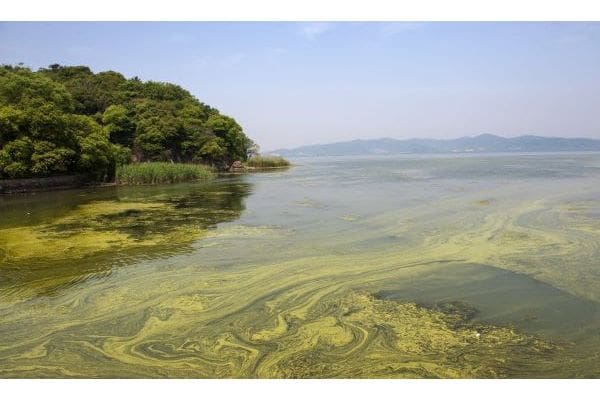Harmful Algal Bloom Threatens California's Coastal Marine Life

Table of Contents
Understanding Harmful Algal Blooms (HABs) in California
Harmful algal blooms (HABs) are proliferations of algae in water bodies, often resulting in discoloration of the water (often called a "red tide," though not all HABs are red). These blooms are caused by various types of microscopic algae, including dinoflagellates and diatoms, which under certain conditions, reproduce rapidly. In California, several factors contribute to the increasing frequency and intensity of HAB events.
-
Increased Nutrient Pollution: Agricultural runoff containing fertilizers and wastewater discharge introduce excessive nutrients (nitrogen and phosphorus) into coastal waters. This nutrient enrichment fuels the rapid growth of algae, creating the conditions for HABs.
-
Elevated Water Temperatures: Climate change is causing a rise in ocean temperatures, creating ideal conditions for the proliferation of certain HAB species. Warmer waters can accelerate algal growth rates and extend the bloom season.
-
Changes in Ocean Currents and Upwelling: Alterations in ocean currents and upwelling patterns can transport nutrients and HABs to new areas, expanding their reach and impact. Changes in wind patterns can also contribute to this.
-
Specific HAB Species: California waters experience blooms of various harmful algae, including Pseudo-nitzschia, which produces domoic acid, a neurotoxin that accumulates in shellfish and can cause amnesic shellfish poisoning (ASP). Other species pose different threats to marine ecosystems.
Devastating Impacts on California's Coastal Marine Life
The toxic effects of HABs on marine organisms are devastating. Many algae produce toxins that can cause illness and death in a wide range of species.
-
Shellfish Contamination: Filter-feeding shellfish, like mussels and clams, accumulate toxins produced by HABs, posing a significant risk to human health if consumed. This leads to shellfish harvesting closures, impacting the fishing industry.
-
Mass Mortality Events: High concentrations of toxins can cause mass mortality events in fish populations, impacting the overall health of the marine food web. Fish kills can have cascading effects throughout the ecosystem.
-
Marine Mammal Impacts: Marine mammals, such as sea lions and whales, can suffer respiratory problems, neurological damage, and even death from exposure to HAB toxins. Sea lion strandings have been linked to HABs in California.
-
Seabird Impacts: Seabirds that feed on affected fish or shellfish can experience reduced foraging success, reproductive failure, and even mortality due to HAB toxins.
Monitoring and Mitigation Strategies for HABs
Monitoring HABs is crucial for protecting marine life and human health. State agencies and research institutions employ various methods:
-
Satellite Imagery: Satellite remote sensing can detect changes in water color, indicating the presence and extent of algal blooms.
-
Water Sampling: Regular water sampling allows for the identification and quantification of HAB species and toxins.
Mitigation strategies focus on reducing the factors that contribute to HABs:
-
Early Warning Systems: Developing and implementing advanced early warning systems for predicting HAB outbreaks is crucial for timely response and mitigation efforts.
-
Improved Agricultural Practices: Implementing sustainable agricultural practices to minimize nutrient runoff from fertilizers is essential.
-
Advanced Water Filtration: Investing in and developing advanced water filtration technologies for wastewater treatment plants can remove excess nutrients before they reach coastal waters.
-
Public Awareness: Educating coastal communities about the dangers of HABs and the importance of reporting suspicious blooms is crucial.
The Economic Impact of HABs on California's Coastal Communities
HABs have substantial economic consequences for California's coastal communities:
-
Fishing Industry Impacts: Shellfish harvesting closures and reduced fish catches due to HABs significantly impact the fishing industry, leading to lost revenue and jobs.
-
Tourism Impacts: Beach closures and warnings due to HABs can drastically reduce tourism revenue, affecting businesses reliant on coastal recreation.
-
Governmental Costs: The costs associated with monitoring, mitigation, and cleanup efforts place a significant financial burden on government agencies and coastal communities.
Conclusion
Harmful algal blooms (HABs) represent a significant and growing threat to California's coastal marine life and the health of its economy. The complex interplay of factors contributing to HABs necessitates a multi-faceted approach involving improved monitoring, effective mitigation strategies, and increased public awareness. Understanding the dangers of harmful algal blooms is crucial for protecting California's precious coastal ecosystem. Learn more about HABs and support initiatives aimed at reducing nutrient pollution and improving coastal water quality. Together, we can combat the threat of HABs and safeguard California's marine life for future generations. Stay informed about local HAB alerts and report any suspicious algal blooms to the appropriate authorities.

Featured Posts
-
 Bts Mega Reunion Speculation Soars After Cryptic 7 Trailer
May 30, 2025
Bts Mega Reunion Speculation Soars After Cryptic 7 Trailer
May 30, 2025 -
 El Odio Y La Admiracion Un Tenista Argentino Y La Leyenda De Rios
May 30, 2025
El Odio Y La Admiracion Un Tenista Argentino Y La Leyenda De Rios
May 30, 2025 -
 New Us Solar Duties How Hanwha And Oci Plan To Expand Market Share
May 30, 2025
New Us Solar Duties How Hanwha And Oci Plan To Expand Market Share
May 30, 2025 -
 Ne Vykhodite Iz Doma Ekstrennoe Preduprezhdenie Politsii Izrailya
May 30, 2025
Ne Vykhodite Iz Doma Ekstrennoe Preduprezhdenie Politsii Izrailya
May 30, 2025 -
 From Poop Papers To Podcast Gold Ai Digest Technology
May 30, 2025
From Poop Papers To Podcast Gold Ai Digest Technology
May 30, 2025
